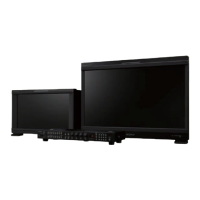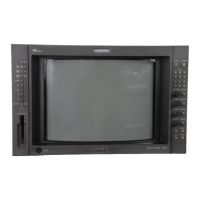Communication Protocol
4
Ethernet
Communication
Protocol
You can control the monitor using the Simple Display
Control Protocol (SDCP) and the Simple Display
Advertisement Protocol (SDAP), which define the
packet conventions and communication procedures for
the commands.
SDCP is used to exchange monitor commands and
statuses. You can obtain video settings and information,
modify system settings including networking settings
and obtain information using Video Monitor Control
(VMC) packets superimposed on the SDCP protocol.
The SDAP protocol periodically broadcasts the status of
devices using UDP to check the connections.
For more information on the SDCP protocol, refer to
section SDCP on page 4.
SDAP
The monitor provides the Status Advertisement Service.
This service allows for the development of host
applications that automatically find devices on the
network. Monitors and controllers periodically
broadcast device information over the network.
Function
The following table shows the device information that is
periodically (at regular intervals) sent out to the network
as broadcast packets:
Advertised information
Protocol definition
The following table defines the SDAP protocol used to
implement this advertisement service:
Definition of the SDAP protocol
SDCP
This protocol provides a service for remotely controlling
the monitor.
Function
This service responds to the control commands and
requests for status and information sent from the host
controller.
The unit provides four connection modes: Single
connection, Peer to Peer connection, Group connection,
and All connection. The Single connection and Peer to
Peer connection modes send SDCP packets using TCP
to identify a single monitor. The Group connection and
All connection modes send SDCP packets using UDP
broadcast function within the area network to identify
more than one monitor. The controller can obtain status
information from the monitor only if they are connected
via TCP. Do not perform status sensing when
connecting via UDP.
Protocol definition
The following table defines the SDCP protocol used to
implement this service:
Definition of the SDCP protocol
Considerations on communication
• Do not issue the next command from the controller
until you receive the return data for the previous
command from the monitor. Otherwise, the monitor
cannot receive the next command and thus cannot
respond to the controller nor issue an error code.
Refer to “Wait time for return data” (on page 5) for
information on the wait time between the controller
issuing a command and the monitor responding with
the return data.
Information Description
Category Category of the device (0Bh)
Device name Name of the device
Serial number Serial number of the device
Location Location of the device
Community Community name of the device
Power status Power on/off status of the device
Category Description
Protocol name SDAP (Simple Display Advertisement
Protocol)
Transport type UDP
Port number 53862
Broadcast interval Monitor: 15 seconds
Controller: 30 seconds
Category Description
Protocol name SDCP (Simple Display Control Protocol)
Transport type TCP and UDP
Port number 53484
TCP connection
timeout
30 seconds

